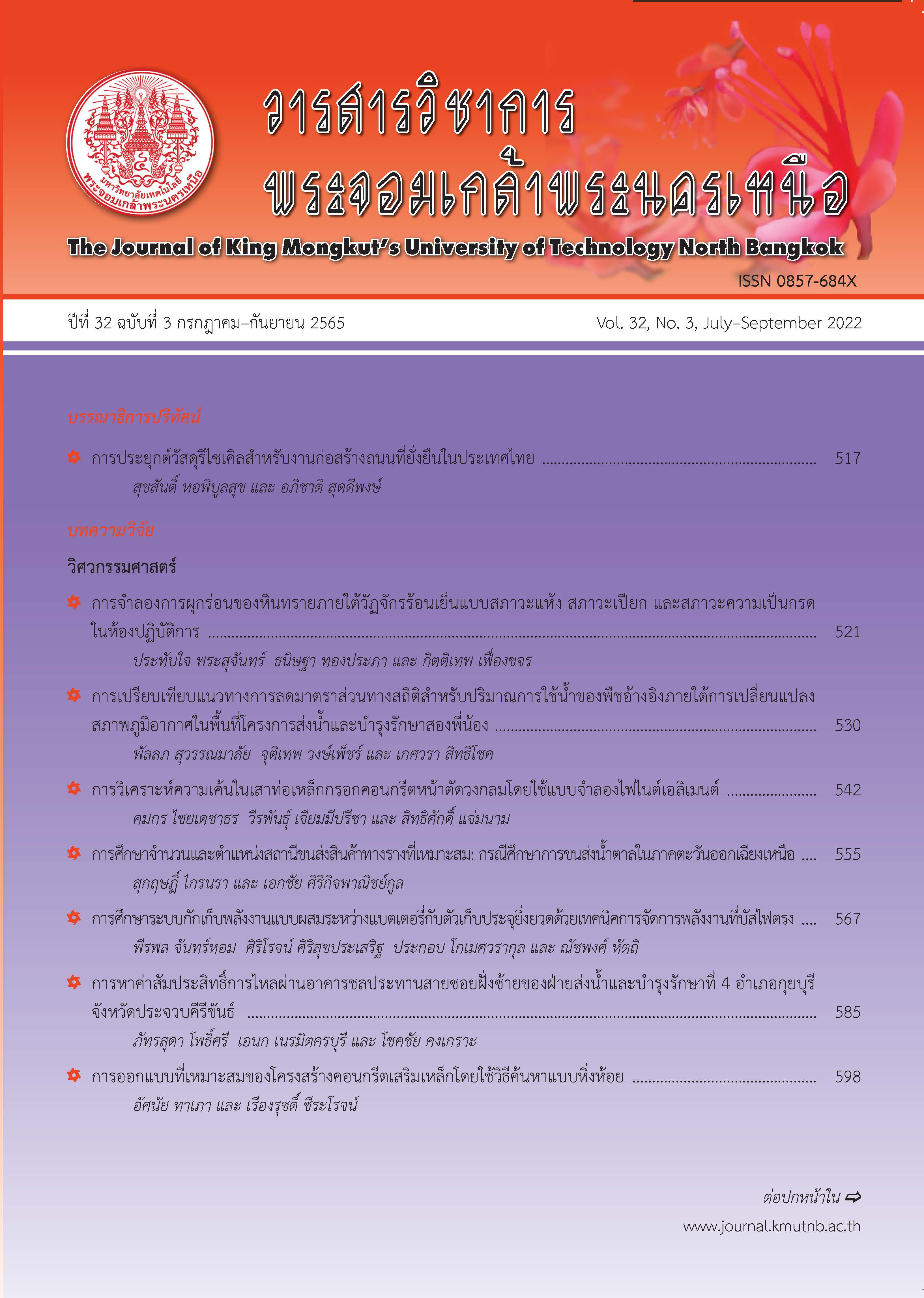การเปรียบเทียบแนวทางการลดมาตราส่วนทางสถิติสำหรับปริมาณการใช้น้ำของพืชอ้างอิงภายใต้การเปลี่ยนแปลงสภาพภูมิอากาศในพื้นที่โครงการส่งน้ำและบำรุงรักษาสองพี่น้อง
Main Article Content
บทคัดย่อ
งานวิจัยนี้มีวัตถุประสงค์เพื่อเปรียบเทียบความแม่นยำของแนวทางการลดมาตราส่วนทางสถิติสำหรับปริมาณการใช้น้ำของพืชอ้างอิง ซึ่งคำนวณโดยสมการ Penman-Montieth ในพื้นที่โครงการส่งน้ำและบำรุงรักษาสองพี่น้อง ซึ่งประกอบด้วย 2 แนวทาง ได้แก่ 1) การลดมาตราส่วนทางสถิติของปัจจัยสภาพภูมิอากาศท้องถิ่นสำหรับการคำนวณปริมาณการใช้น้ำของพืชอ้างอิง (Statistical Downscaling to ETo Penman-Montieth; SD-PM) และ 2) การลดมาตราส่วนทางสถิติของปริมาณการใช้น้ำของพืชอ้างอิงโดยตรง (ETo Penman-Montieth to Statistical Downscaling; PM-SD) โดยกระบวนการสอบเทียบและทวนสอบเพื่อตรวจพิสูจน์ความแม่นยำของแนวทางการลดมาตราส่วนดำเนินการโดยเปรียบเทียบระหว่างปริมาณการใช้น้ำของพืชอ้างอิงที่คำนวณโดยสภาพภูมิอากาศตรวจวัดและค่าที่ได้จากกระบวนการการลดมาตราส่วนทางสถิติทั้ง 2 แนวทาง โดยกำหนดช่วงเวลาสำหรับการสอบเทียบและการทวนสอบตั้งแต่ ค.ศ. 1987 ถึง ค.ศ. 1997 และ ค.ศ. 1998 ถึง ค.ศ. 2005 ตามลำดับ จากผลการศึกษาพบว่าแนวทาง PM-SD มีความแม่นยำในการลดมาตราส่วนทางสถิติสำหรับปริมาณการใช้น้ำของพืชอ้างอิงมากกว่าแนวทาง SD-PM ซึ่งบ่งชี้โดยดัชนีทางสถิติซึ่งประกอบด้วย ค่าสัมประสิทธิ์สหสัมพันธ์ ค่าสัมประสิทธิ์การตัดสินใจ ค่าเฉลี่ยของกำลังสองของความคลาดเคลื่อน ค่ารากที่สองของความคลาดเคลื่อนและค่าร้อยละความเอนเอียงของการประมาณ ดังนั้นแนวทาง PM-SD จึงมีความเหมาะสมในการสร้างภาพฉายอนาคตสำหรับปริมาณการใช้น้ำของพืชอ้างอิงซึ่งเป็นส่วนหนึ่งของขั้นตอนการพัฒนามาตรการการปรับตัวภายใต้การเปลี่ยนแปลงสภาพภูมิอากาศสำหรับการบริหารจัดการน้ำชลประทานในพื้นที่โครงการส่งน้ำและบำรุงรักษาสองพี่น้อง
Article Details

อนุญาตภายใต้เงื่อนไข Creative Commons Attribution-NonCommercial-NoDerivatives 4.0 International License.
บทความที่ลงตีพิมพ์เป็นข้อคิดเห็นของผู้เขียนเท่านั้น
ผู้เขียนจะต้องเป็นผู้รับผิดชอบต่อผลทางกฎหมายใดๆ ที่อาจเกิดขึ้นจากบทความนั้น
เอกสารอ้างอิง
L. J. Wade, S. Fukai, B. K. Samson, A. Ali, and M. A. Mazid, “Rainfed lowland rice: Physical environment and cultivar requirements,” Field Crops Research, vol. 64, no. 1–2, pp. 3–12, 1999.
D. J. Griggs and M. Noguer, “Climate change 2001: The scientific basis. Contribution of working group I to the third assessment report of the intergovernmental panel on climate change,” Weather, vol. 57, no. 8, pp. 267–269, 2002.
W. L. Gates, J. S. Boyle, C. Covey, C. G. Dease, C. M. Doutriaux, R. S. Drach, and T. J. Phillips, “An overview of the results of the atmospheric model intercomparison project (AMIP I),” Bulletin of the American Meteorological Society, vol. 80, no. 1, pp. 29–56, 1999.
C. Y. Xu, “From GCMs to river flow: A review of downscaling methods and hydrologic modelling approaches,” Progress in Physical Geography, vol. 23, no. 2, pp. 229–249, 1999.
R. L. Wilby, C. W. Dawson, and E. M. Barrow, “SDSM-a decision support tool for the assessment of regional climate change impacts,” Environmental Modelling & Software, vol. 17, no. 2, pp. 145–157, 2002.
S. Gagnon, B. Singh, J. Rousselle, and L. Roy, “An application of the statistical downscaling model (SDSM) to simulate climatic data for streamflow modelling in Québec,” Canadian Water Resources Journal, vol. 30, no. 4, pp. 297–314, 2005.
T. PrikMak, “Prediction of temperature and rainfall amount in upper ping river basin under global climate change scenarios,” M.S. thesis, Department of Water Resources Engineering, Kasetsart University, 2010 (in Thai).
W. Wang, W. Xing, and Q. Shao, “How large are uncertainties in future projection of reference evapotranspiration through different approaches?,” Journal of Hydrology, vol. 254, pp. 696–700, 2015.
R. G. Allen, L. S. Pereira, D. Raes, and M. Smith, “Crop evapotranspiration– Guidelines for computing crop water requirements,” Irrigation and Drainage Paper No. 56, FAO, Rome, Italy, 1998.
R. L. Wilby, C. W. Dawson, and E. M. Barrow, “SDSM 4.2-A decision support tool for the assessment of regional climate change impacts,” Lancaster University, Lancaster/Environment Agency of England and Wales, Lancaster, 2007.
P.Thawirat, Research Methods in Behavioral and Social Sciences, Bangkok: Educational and Psychological Test Bureau, Srinakharinwirot University, 1997, pp. 144 (in Thai).
P. Suwanmalai, J. Vongphet, and K. Sittichok, “Selection of global climate variable correlated to local climate data influencing crop water requirement in the Song Phi Nong operations and maintenance project,” in Proceedings the 20th TSAE International Conference, 2019, pp. 179–185 (in Thai).

